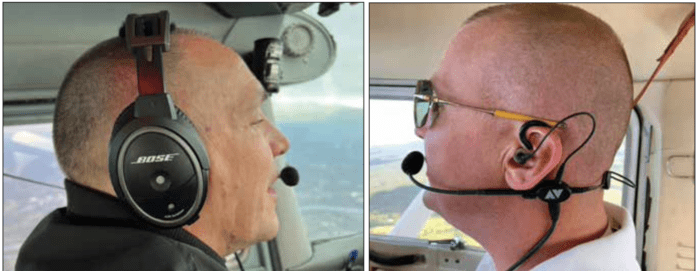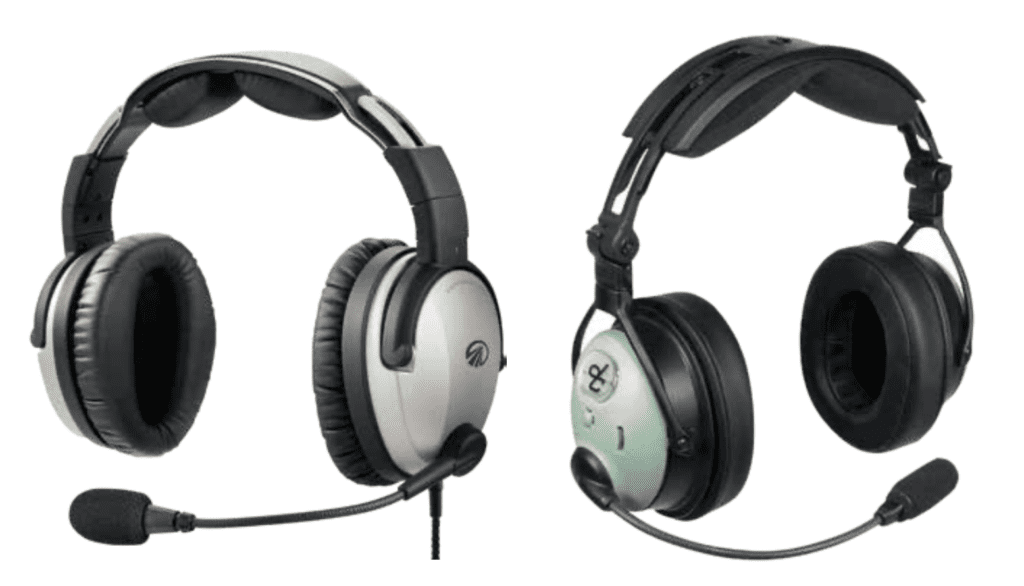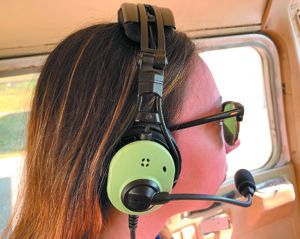
A couple of modern headsets for rear-seat passengers, a more comfy and better-sounding set for the right-seater or the student pilot on a budget—there will always be a market for used headsets.
And like used avionics, there are good deals and bad deals. We think the good purchases are sets that started life as exceptional performers, while standing the test of hard time in the cabin and the flight bag. But there must also be good manufacturer support behind the headset.
Whether it’s ordering a new pair of ear cups, a mic wind muff or a full-up factory bench repair, support is a must. Sour buys are sets that arrive damaged, leaving the buyer stuck because the manufacturer stopped repairing it. It takes a good eye.
So by popular demand, here are our top picks for used-market headsets, based on the results of our long-term evaluation a variety of mid-priced models. Plus, we included some tips for shopping a crowded market.
VARYING DESIGNS
No, headset shopping isn’t easy, especially for noobs. We’ve been wearing headsets long enough to accept that there’s a sizable tradeoff for comfort and performance. At this point, we simply couldn’t fly with a passive set (other than an in-ear model, which we’ll explain), so noise cancellation ranks high. When shopping, consider fit and comfort, and realize that one size and acoustic design doesn’t fit all. You have to try them before buying them—and that’s not easy when shopping used.
Supra-aural headsets—generally more compact—have earcups that sit on top of the ear, while a circumaural fits completely around the ear. In-ear models use ear buds for a minimalist wearing experience. It’s worth a few words on these.
At one point, in-ear models were snubbed because people just didn’t like sticking things in the ears. Our theory is that smartphone and tablet use with wireless earbuds might have changed that. One in-ear design has been a reliable standout. We’ll start there.
CLARITY ALOFT
We liked the audio performance of the Aloft Technologies Clarity Aloft in-ear model so much we bought a set and it’s been a staple in the flight bag. It’s not a full-time headset because it performs better in quieter cabins, even though it has noise dampening (30 to 47 dBA) similar to ANR models when the buds are fitted correctly in the ear canal.
Minnesota-based Aloft Technologies has offered the Clarity line since 2004 so there’s been plenty of time to improve the overall design, including offering the Flex model that weighs 1.35 ounces over the original 1.5-ounce metal-band Clarity. We evaluated both, and unanimously our wearers agreed that the Flex reduced some pressure points that might exist with the original Clarity, and that a Bluetooth module should come standard. It doesn’t. If you do any airline flying, the Clarity is TSO’d and a good performer in turbines. Read the full report in the November 2019 Aviation Consumer.
On the used market, we found several used Clarity and Clarity Flex models for sale around $500 to $600. New ones are $775 and have a three-year warranty.

DAVID CLARK
Known for its above-and-beyond factory support in Worcester, Massachusetts, we’ve never had a problem recommending David Clark headsets, and two standout models in our long-term test pool are worth hunting on the used market.
The circumaural David Clark OneX turned out to be a good set for smaller heads because of its smaller lightweight alloy headband that has a broad range of adjustment. The tradeoff is higher clamping forces. Still, for eyeglasses-wearing pilots and passengers, that tighter clamping force pays off because this headset offers a good seal, which helps with noise-canceling performance. What helps are soft leatherette ear seals, which David Clark says reduce heat buildup, and we found that to be true. At nearly an inch thick and made of slow recovery memory foam, the oval-shaped seals also help absorb some of the pressure around the ear.
The OneX has hybrid ENC circuitry that samples noise with two microphones. One mic is positioned on the exterior of the headphone dome, which isolates the mic from the internal speaker. This is called the feed-forward portion of the circuit, while a second mic is placed inside the dome adjacent to the speaker, as the feed-back portion of the circuit. Both the external and internal microphones send the sampled noise signals into a noise cancellation processor, which contains two inversion circuits, creating an anti-noise signal. The signal is then amplified and passed along to the speaker inside of the earcup.
The OneX has a good Bluetooth feature set and excellent battery endurance (nearly 50 hours) and the set works reasonably we’ll when powered down and passive. The OneX is priced new at $895, but out of stock at David Clark. We found a few for sale at around $700.
The other good-performing David Clark set in our group is the supra-aural (on-the-ear) PRO-X2. It’s a favorite for petite heads because of its light weight (7.5 ounces) and small footprint. But small doesn’t mean it isn’t rugged. The set—particularly the aluminum headband/suspension system—has held up we’ll nearly five years into our long-term use. The control module is simple and sized right, the Bluetooth works we’ll and the set’s ANR circuitry with automatic gain control is a decent performer in a wide variety of cabins.
The PRO-X2 was really designed for turbine cockpits but it can work in pistons, too. Although, not surprisingly given the supra-aural design, the circuitry works hard in loud cabins. Some ANR rumble is possible at high power settings. The PRO-X2 lists for $745 new, and we found several gently used sets for sale between $500 and $650. David Clark headsets have a five-year warranty and repair pricing is established once the company evaluates the set.
BOSE AND LIGHTSPEED
At this point, the Lightspeed Zulu 2 (released somewhere around 2011) in our test pool is old—long replaced by the Zulu 3—but it has worked well, and the company sold a lot of them. That makes the set easy to find on the used market.
If you buy one right, you can make it even better because Lightspeed has a $300 factory upgrade program in place. It basically turns an older Zulu 2 into a Zulu 3 by installing a tough Kevlar-cored braided audio cable (a huge improvement), swapping the control module and replacing the ear seals, head- pad and mic muff. The upgrade also includes a three-year warranty. Even if you don’t upgrade, a used Zulu 2 (priced from $300 to $500) isn’t a bad choice. It has good ANR circuitry, decent battery life (40 hours) and it’s reasonably comfortable. We think it’s a good choice for students on a budget.
Lightspeed Aviation in Oregon charges a $175 flat-rate fee for repairs on sets that are out of warranty. This covers parts, labor and the replacement of “soft goods,” which are ear seals, the headband and mic muff. That’s not trivial, but we also think it’s fair. Budget it into the price just to be safe.
We compared the discontinued (but still readily supported) Bose A20 to the A30 in the June 2023 Aviation Consumer and found that while the A30 was more comfortable thanks to a smart redesign of the hardware, we aren’t kicking our well-worn A20 out of the flight bag. Still, the A30 has created an A20 feeding frenzy on the used market.
There are even new A20s on the market for around $1000, but at that price we say go for the A30. But in general, the going price for a working A20 with storage case is around $700 to $800. The A20 without Bluetooth generally sells for around $600. For an A20 that’s been treated right, we think it’s a solid buy, especially if it’s been back to Bose for repair.
For headsets out of the original five-year warranty, the flat-rate repair charge is $225. Bose offers a limited 90-day warranty on repairs. At Bose, anytime a headset is sent in for repair it not only works to fix what’s broken and returns it to original performance specs, but it replaces the ear cushions, headband cushions and the mic muff, plus it cleans the set up so it arrives back to the owner in good condition.

Learning to fly or even working on new ratings? Perhaps one of the best investments you can make in your training is a quality noise-canceling headset, and there are plenty of good ones on the used market for lower budgets.
Think about it. As a student pilot, the actual aircraft presents the most unfavorable environment for learning because of noise, vibration, overwhelming radio chatter and other stresses. As a flight instructor, I see how distracted students get and it’s worsened with poor headset audio. I’ve also discovered (even in my own training) that a good noise-canceling headset helps the learning experience, and I tell my students that the benefits of a good headset easily outweigh the high initial cost.
I’ve seen numerous student pilots achieve their private pilot certificate in less time than their peers simply because they prioritized their learning by purchasing a high-quality headset. Being able to knock your initial training out in 25 hours less compared to not having a noise-canceling headset is an enormous cost savings. Plus, many students just don’t realize that noise-canceling headsets help fight against hearing loss—which is the reality of a long flying career. Can’t afford a new ANR headset? I say hit the used market. That’s the David Clark Pro X2 ANR headset pictured here working hard in the training environment.
— Phil Smith, Learn2FlyCT
SOURCE IT RIGHT
There are so many places to buy used headsets we can’t list them here—from FBO bulletin boards to Facebook groups and eBay. And as with used avionics, you really won’t know the actual condition until you get the set in your hands. Get photos of the audio plugs because some sets might have a single-plug LEMO interface that may or may not work in your aircraft.
Luckily, these days it’s easy to ask for lots of good high-res images, plus make a deal with someone who will guarantee the set works. Still, budget some money in the deal to change out the stuff that wears. This includes earcups, headpads and microphone muffs. Who wants to wear someone else’s sweat?
If you’re unsure of a model’s status (as far as supportability), simply call the manufacturer with the model and serial number of the set you’re making a deal on. Some just aren’t worth it in the long run because they might be unsupported in the future. Lightspeed’s Teresa De Mers made a good point in that current-production ANR models like the Zulu 3 and even the older Zulu 2 have impressively high resale values. That could mean that you’re better off buying a new set that has a full warranty—and more modern styling and features.
On the other hand, used sets that are still being produced could very we’ll be covered under the original warranty, which sweetens the deal even when lightly discounted.
One final thought turns to headsets that have been stolen—and there are plenty that have been lifted. You don’t want these, especially if they have been reported to the manufacturer as stolen. Again, check the serial numbers with the company and if a set shows up for sale locally that seems like a really good bargain, ask around before buying.
If you have your eyes on a used model but aren’t sure if it’s worth it, drop us a line and we’ll help you noodle the decision.

